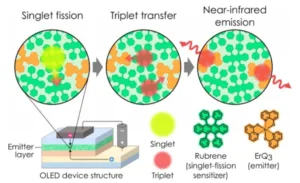A group from Kyushu University in Japan has developed a way to ‘split energy’ in OLEDs and go beyond the 100% limit for exciton production.
OLEDs use layers of carbon-containing organic molecules to convert electrical charges into light. In normal OLEDs, one positive charge and one negative charge come together on a molecule to form a packet of energy called an exciton. One exciton can release its energy to create at most one beam of light, or photon.
When all charges form excitons that emit light, a maximum 100% internal quantum efficiency is achieved. However, the new technology uses a process called singlet fission to split the energy from an exciton into two, making it possible to exceed the 100% limit for the efficiency of converting charge pairs into excitons, also known as the exciton production efficiency.
“Put simply, we incorporated molecules that act as change machines for excitons in OLEDs. Similar to a change machine that converts a $10 bill into two $5 bills, the molecules convert an expensive, high-energy exciton into two half-price, low-energy excitons,”
explained Hajime Nakanotani, associate professor at Kyushu University and co-author of the paper describing the new results.
Excitons come in two forms, singlets and triplets, and molecules can only receive singlets or triplets with certain energies. The researchers overcame the limit of one exciton per one pair of charges by using molecules that can accept a triplet exciton with an energy that is half of the energy of the molecule’s singlet exciton.
In such molecules, the singlet can transfer half of its energy to a neighboring molecule while keeping half of the energy for itself, resulting in the creation of two triplets from one singlet. This process is called singlet fission.
The triplet excitons are then transferred to a second type of molecule that uses the energy to emit near-infrared light. In the present work, the researchers were able to convert the charge pairs into 100.8% triplets, indicating that 100% is no longer the limit. This is the first report of an OLED using singlet fission, though it has previously been observed in organic solar cells. The group hope to get to 125% excition production as electrical operation leads to 25% singlets and 75% triplets. They then plan to try to convert the triplets into singlets with a target of 200% IQE.
Illustration of the singlet fission process used to boost the number of excitons in an OLED and break the 100% limit for exciton production efficiency. A singlet exciton, which is created when a positive charge and a negative charge combine on a rubrene molecule, can transfer half of its energy to a second rubrene molecule through the process of singlet fission, resulting in two triplet excitons. The triplet excitons then transfer to ErQ3 molecules, and the exciton energy is released as near-infrared emission by ErQ3.
The group has a published paper here.
The technology is believed to have applications in biology, medicine and communications.

